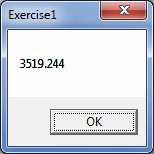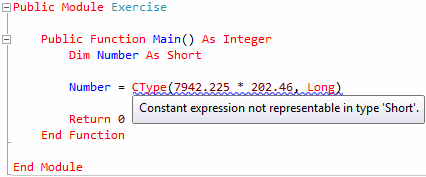|
|
You may recall that when studying data types, we saw
that each had a corresponding function used to convert a string value or
an expression to that type. As a reminder, the general syntax of the
conversion functions is:
|
ReturnType = FunctionName(Expression)
The Expression could be of any kind. For
example, it could be a string or expression that would produce a value
such as the result of a calculation. The conversion function would take
such a value, string, or expression and attempt to convert it. If the
conversion is successful, the function would return a new value that is of
the type specified by the ReturnType in our syntax.
The
conversion functions are as follows:
|
Function |
|
|
Name |
Return Type |
Description |
| CBool |
Boolean |
Converts an expression into a
Boolean value |
| CByte |
Byte |
Converts an expression into Byte
number |
| CDbl |
Double |
Converts an expression into a
floating-point number with double precision |
| CDec |
Decimal |
Converts an expression into a
decimal number |
| CInt |
Integer |
Converts an expression into an
integer (natural) number |
| CLng |
Long |
Converts an expression into a
long integer (a large natural) number |
| CObj |
Object |
Converts an expression into an
Object type |
| CSByte |
SByte |
Converts an expression into a
signed byte |
| CShort |
Short |
Converts an expression into a
short integer |
| CSng |
Single |
Converts an expression into a
floating-point number with single precision |
| CUInt |
UInt |
Converts an expression into an
unsigned integer |
| CULng |
ULong |
Converts an expression into an
unsigned long integer |
| CUShort |
UShort |
Converts an expression into an
unsigned short integer |
Conversion functions allow you to convert a known
value to a another type. Besides these functions, the Visual Basic
language provides a function named CType. Its syntax is:
CType(expression, typename)
As you can see, the CType() function takes two
arguments. The first argument is the expression or the value that you want
to convert. An example could be name of a variable or a calculation:
CType(250.48 * 14.05, ...)
The second argument is the type of value you want to
convert the first argument to. From what have learned so far, this second
argument can be one of the data types we reviewed in Lesson 3. Here is an
example:
CType(250.48 * 14.05, Single)
If you choose one of the Visual Basic language's data
types, the expression produced by the first argument must be able to
produce a value that is conform to the type of the second argument:
- The conversion from the first argument to the type of the second
argument must be possible: the value produced by the first must be
convertible to the second arguments. For example, if the first
argument is a calculation, the second argument must be a number-based
data type. In the same way, you cannot convert a date to a
number-based type
- If the first argument is a number or the result of a calculation,
its resulting value must be lower than or up to the range of values of
the second argument. Here is an example:
Public Module Exercise
Public Function Main() As Integer
MsgBox(CType(250.48 * 14.05, Single))
Return 0
End Function
End Module
This would produce:

|
- If the first argument is a number or the result of a calculation
that produces an integer or a floating-point number, its resulting
value must be convertible to an integer or a floating point number up
to the range of values of the second argument. Here is an example:
Public Module Exercise
Public Function Main() As Integer
MsgBox(CType(7942.225 * 202.46, UInteger))
Return 0
End Function
End Module
This would produce:

|
- If the first argument is a number or the result of a calculation
that produces an integer or a floating-point number, the second
argument is a number-based data type but whose range cannot hold the
resulting value of the first argument, the conversion would not be
allowed (the conversion will fail):
After the CType() function has performed its
conversion, it returns a value that is the same category as the second
argument. For example, you can call a CType() function that
converts an expression to a long integer. Here is an example:
Public Module Exercise
Public Function Main() As Integer
Dim Number As Long
Number = CType(7942.225 * 202.46, Long)
Return 0
End Function
End Module
The function can also return a different type, as long
as its type can hold the value produced by the expression. Here are two
examples:
Public Module Exercise
Public Function Main() As Integer
Dim Number As UInteger
Number = CType(7942.225 * 202.46, Long)
Return 0
End Function
End Module
Or
Public Module Exercise
Public Function Main() As Integer
Dim Number As Single
Number = CType(7942.225 * 202.46, Long)
Return 0
End Function
End Module
If you try storing the returned value into a variable
that cannot hold it, you would receive an error:
